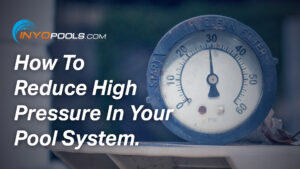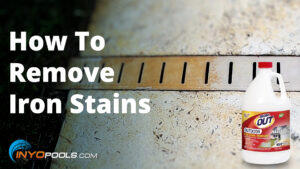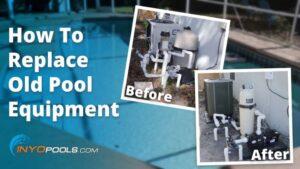A weak pool jet is one of the most frequent problems for pool owners. If you ask a pool professional “Why are my pool jets not working?”, you may receive a blank stare and a pause. This reaction is due to the fact that we know the solution could be simple, but narrowing it down is time-consuming. We’ll separate the cause of low pool jet pressure into two parts. This will hopefully save you time from reading a section that doesn’t pertain to your situation. Part I will discuss low jet pressure when the filter gauge has a low PSI reading. In Part II we’ll discuss low jet pressure when the filter gauge has a high PSI reading.
Part I Weak Jets and Low PSI
Some of you may be wondering what would be considered a low PSI. Anything lower than your normal operating PSI is considered low. For example, let’s say your normal operating PSI is 10-15. If your gauge is reading 5 PSI, it’s low. This would result in the pool jets not being as strong as expected. Unless you’ve recently lowered the horsepower or RPMs of the pump, low jet pressure is a problem and it needs to be corrected.
The Obvious but Overlooked
The water level of your pool should be checked first. It needs to be at least halfway up the skimmer door’s opening. A low water level can cause a pump to take in air. This will not only decrease flow, but it will cause the pump to run dry and burn up.
Empty the skimmer basket and pump basket of any debris. This should be part of the regular pool maintenance, but it’s a simple task that is often overlooked. A clogged basket can cause the pump to work harder as it tries to circulate the water. Again, this can result in damage to the pump.
Air Is the Enemy
The most common reason for weak jets is an air leak. An air leak would come from the suction side of the system. This would be the area between the skimmer and the pump. One way to determine if you have an air leak is by looking for air bubbles coming out of the return jets. Another sign is air in the pump strainer. The pump strainer, in most cases, should be full of water and have no visible air.
Pump lid O-rings are a habitual offender of air leaks. The O-ring can expand or deteriorate over time and allow air to enter the pump. You can try applying a silicone or Teflon lubricant to see if it helps, but often times it needs to be replaced.
Plumbing fittings will also draw air. A popular technician trick is to use burning incense. While the pump is running, wave the burning incense near suspected areas. The smoke will be drawn in, if there is a leak. Check the fitting on the pump intake, the couplings and elbows. Cut out and replace any fittings that have an air leak.
Valves can be inspected like the plumbing fittings. Diverter valves will usually have internal O-rings. These O-rings can easily be replaced to fix an air leak. Simple ball valves are not usually repairable and need to be replaced, if there is a leak.
Drain plugs are found on most pumps. These plugs are usually used to drain the pump when a pool is winterized. They should be tightened firmly into the pump. Inspect the drain plug and drain plug O-ring. Replace them if they look decrepit.
Pump Problems
Pool owners often tell us that the pool pump pressure is too low. With low jet pressure, the cause could be a damaged or clogged impeller. The pump will need to be split in half in order to inspect the impeller. Dog hair, pine needles and other small debris are main culprits for a clogged impeller. Replace the impeller if the body or any of the veins are cracked.
If the pump strainer is not full of water and an air leak has been ruled out, your pump may not be fully primed. With the pump off, remove the lid and fill the strainer with water. Keep the water running for a couple minutes. This will allow the pipes to fill with water. If you turn on the pump and it still struggles to prime, it could be an issue with the suction-side plumbing. Check out our article titled “How To: Fix Priming Problems In Your Pool Plumbing” for an in-depth look at priming problems.
Plumbing Issues
There may be a clogged suction side line if very little or no water is entering the pump. This will often occur if a leaf trap or vac plate is not used when vacuuming the pool. The clog will occur between the skimmer or vacuum port and the pump. A traditional plumbing snake will not usually work on pool plumbing, because of all the 90° turns. We recommend using an electrician’s fish tape or a drain cleaning water bladder.
Part II Weak Jets and High PSI
What is a high PSI? The general rule is that 10 PSI above the normal operating pressure is considered high. A high PSI reading should be addressed quickly. Damage to the filter, pump and plumbing can occur if high PSI is sustained.
The Primary Suspect
The predominant factor for high PSI and low flow is a dirty filter. Cleaning the pool filter will normally lower the PSI and improve jet flow. In order to clean, sand and DE filters need to be backwashed and cartridge elements need to be hosed down. DE grids and cartridges can be soaked in a filter cleaner to remove oils and grease that aren’t removed during normal cleaning. If the PSI remains high after cleaning the filter, the filter media may need to be replaced. By media, we mean the sand, DE grids or cartridges.
The Swamp Effect
Green Pool ✓ Cloudy Pool✓ No Flow✓ Customers frequently tell us that they clean the filter and 20 minutes later the PSI is high and the flow is poor. Then we ask, “Can you see the bottom of the pool?” and “No” is the consistent response. The reason the PSI is jumping up is because the filter is catching all that extra debris. The first step is killing the algae. The pool usually clouds up after this. The filter will need to be cleaned several times a day until the water is clear. The PSI should normalize once the water is looking good.
Note: If the reading on the pressure gauge does not drop when the pump shuts off, it may be a bad gauge. The pressure gauge is inexpensive and very easy to replace.
We addressed the most popular causes of pool jets not working. If you have any further questions regarding weak pool jets, visit us over at INYOpools.com. Please leave a comment and let us know what corrected your pool pressure issue.
Related Articles
How to Correct Low Water Pressure in Your Pool System
How to Diagnose and Repair Low Water Pressure from Pool Pump













Leave a Reply